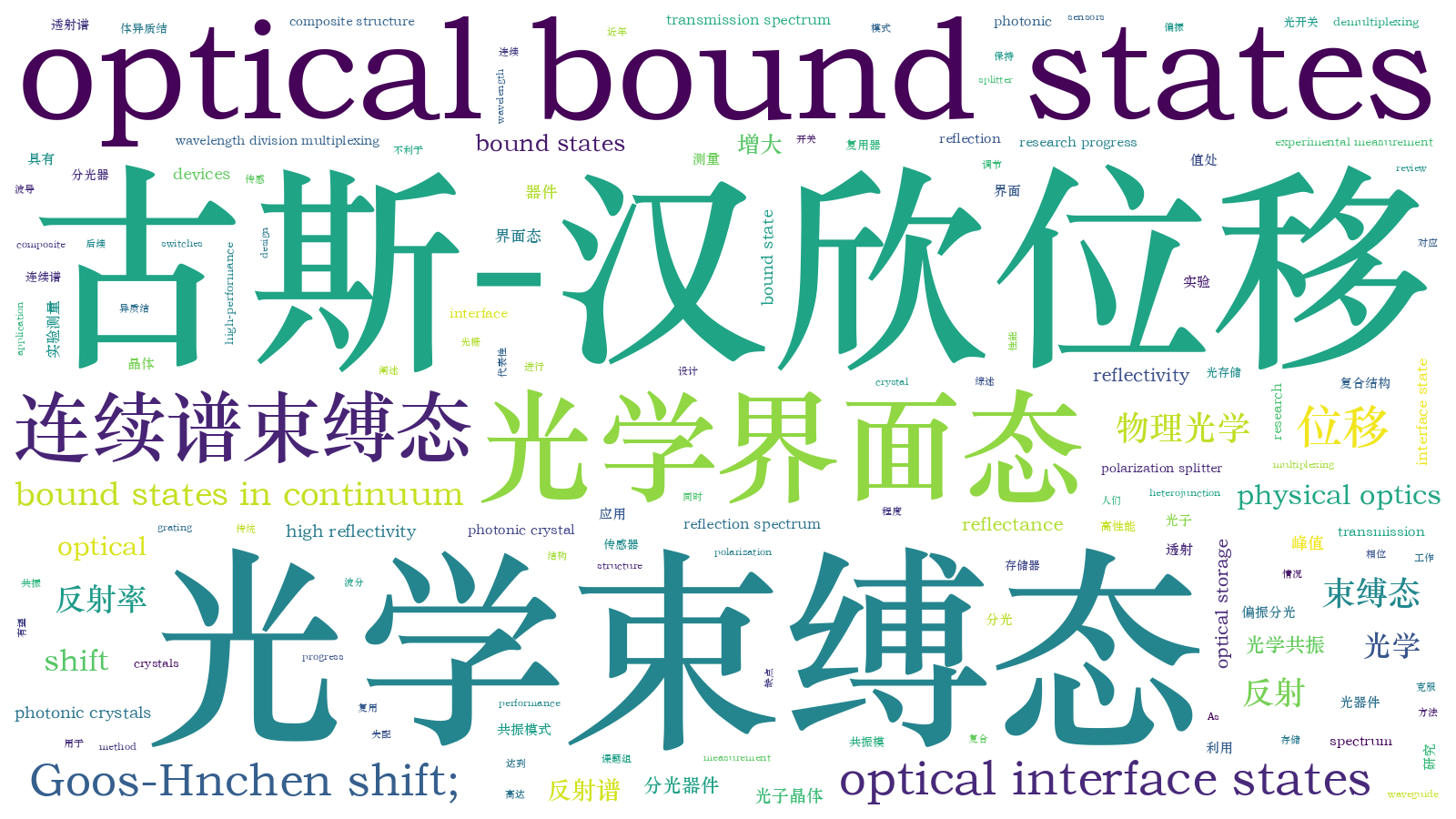基于奇异光学束缚态的古斯-汉欣位移增大  下载: 1307次特邀综述
下载: 1307次特邀综述
1 引言
当一束光从光密介质入射到光疏介质中被全反射时,光沿着界面传播一段距离后被反射回去,这段距离被称为古斯-汉欣位移,于1947年被古斯和汉欣在实验上观测到[1]。古斯-汉欣位移背后的物理机制为:一束有限宽度的光束实际上是具有不同波矢方向的单色平面波的叠加,这些具有不同波矢方向的单色平面波发生全反射时,具有不同的相移,因此这些反射的单色平面波叠加成实际的反射光束后,将使得反射光束偏离原来几何光学预言的反射点,引起一段空间上的横向位移[2-4]。近几十年里,随着理论和实验研究的不断深入,古斯-汉欣位移被广泛应用于各个方面,如各类传感器[5-7]、光开关[8-9]、光存储[10]、波分(解)复用[11-12]和偏振分光[13-14]等。然而,在通常的全反射情形(即从光密介质入射到光疏介质)下,古斯-汉欣位移的大小一般仅为光波长的数倍,这不利于实验测量及实际应用[1]。因此,古斯-汉欣位移的增大成为了一个研究热点。根据稳态相位法,古斯-汉欣位移的大小与反射相位对入射角的变化率成正比[2]。若能使反射相位随入射角的变化率增大,那么古斯-汉欣位移也将增大。迄今为止,主要有两种机制可用于增大古斯-汉欣位移。第一种机制是基于布儒斯特效应。在布儒斯特角附近,反射相位会随着入射角剧烈变化,古斯-汉欣位移可被增大至光波长的数十倍以上[14-18]。第二种机制是基于光学共振效应。由于发生了共振,反射相位在共振角附近会随着入射角剧烈变化,古斯-汉欣位移可被大幅增大[19]。近十几年来,国内外的研究人员利用各种光学共振结构(如弱吸收介质平板[20]、近零介电常数超构材料平板[21]、二维光子晶体平板[22]、狄拉克色散介质平板[23]、金属覆层波导[6]、非对称双棱镜[24]、表面等离激元结构[25]、一维光子晶体[26-28]、受抑全内反射结构[29]和衰减全反射结构[30]等)实现了古斯-汉欣位移的大幅增大。
作为一类具有代表性的光学共振模式,光学束缚态引起了研究人员的广泛关注[31-38]。在光学束缚态所对应的波长处,电磁场将被束缚在某些区域中[39-44]。下面介绍两种典型的光学束缚态。第一种典型的光学束缚态是光学缺陷态。通过在光子晶体中引入合适的缺陷,光子带隙中将会出现光学缺陷态,场强将被局域在缺陷所对应的区域中[45-50]。第二种典型的光学束缚态则是光学界面态。2003年,研究人员发现,在由电单负和磁单负材料组成的异质结中,当虚阻抗匹配条件和虚相位匹配条件同时被满足时,将出现一种非常特殊的光学界面态——光学隧穿模[51]。在隧穿模所对应的波长处,电磁场将局域在电单负和磁单负材料的界面处,并且场强沿着远离界面的方向以指数形式衰减[51]。随后,在2005年和2007年,研究人员分别发现,光学界面模还可存在于由两种一维光子晶体组成的异质结[52]以及由金属和一维光子晶体组成的异质结[53]中。2008年,本课题组从光子晶体的等效介质理论出发,成功地解释了上述两种异质结中光学界面态的产生机制,并在微波波段观测到了由两种一维光子晶体组成的异质结中的光学界面态[54]。其中一种光子晶体可被等效为电单负材料,另一种光子晶体则可被等效为磁单负材料[54]。由于具有共振效应,研究人员利用这两种光学束缚态,将古斯-汉欣位移增大至光波长的数十倍至数千倍[55-58]。然而,在利用光学缺陷态和界面态增大古斯-汉欣位移的上述几项工作中,古斯-汉欣位移的极大值均位于共振角处。由于光学缺陷态和界面态均为透射型共振,古斯-汉欣位移的极大值均位于透射率的极大值(即反射率的极小值)处。在上述几项工作中,反射率的极小值非常小,低于1%甚至0.1%[55-58]。这将导致反射光的强度很弱,使得古斯-汉欣位移难以在实验中被真正测量到,从而不利于基于古斯-汉欣位移的各类应用。那么这个缺点能否被克服呢?
本文将介绍本课题组近年来利用奇异光学束缚态增大古斯-汉欣位移的研究情况[59-60],阐述了本课题组利用连续谱准束缚态(quasi-BIC)增大古斯-汉欣位移的研究情况[59],介绍了本课题组在光栅-波导复合结构中实现连续谱束缚态(BIC)及准束缚态的研究情况。基于连续谱准束缚态的高Q共振特性,古斯-汉欣位移可被大幅增大至光波长的数千倍,且古斯-汉欣位移的极大值位于反射谱的极大值处,反射率高达100%。阐述了本课题组利用光学界面态增大古斯-汉欣位移的研究情况[60]。本课题组在由两种光子晶体组成的异质结中实现了反射率可调的界面态,界面态的反射率由两种光子晶体的虚阻抗的失配程度所决定,当两种光子晶体的虚阻抗的失配程度较大时,界面态的反射率也较大。利用这种具有高反射率的特殊界面态,古斯-汉欣位移可被增大至光波长的数千倍以上。利用上述两种奇异的光学束缚态,本课题组在大幅增大古斯-汉欣位移的同时保持了较高的反射率。这将使得古斯-汉欣位移在实验中更容易被测量到,后续有望将这两种奇异的光学束缚态应用在各类高性能传感器[5-7]、光开关[8-9]、光存储器件[10]、波分(解)复用器件[11-12]和偏振分光器件[13-14]的设计中。
2 基于连续谱准束缚态的古斯-汉欣位移增大
2.1连续谱束缚态和准束缚态简介
首先对连续谱束缚态和准束缚态进行简要的介绍。通常来讲,束缚态是一系列离散存在的态,例如一维有限深势阱中的电子束缚态。然而,von Neumann和Wigner的理论研究表明,当势场满足某种特殊的空间分布时,可以得到一类非常特殊的束缚态,该束缚态位于连续谱中[61]。这种特殊的束缚态后来被称为连续谱束缚态。1985年, Friedrich和 Wintgen的理论研究表明,通过两个不同共振通道之间的干涉,也能实现电子的连续谱束缚态[62]。随后,在2008年,他们的方法被研究人员拓展到了光学系统中,实现了连续谱束缚态[63-64]。
然而,严格的连续谱束缚态具有无穷大的Q因子,无法直接被远场激发,因此难以被人们直接利用。结构参数或入射角等稍微偏离,将会导致出现一个具有极高Q因子的束缚态,被称为连续谱准束缚态。与连续谱束缚态不同,连续谱准束缚态可直接被远场激发。近十余年来,研究人员利用各种光学微结构(如光子晶体平板[65-66]、非对称超表面[67-68]和非对称光栅[69]等)实现了连续谱准束缚态。由于具有高Q的共振特性,连续谱准束缚态被广泛应用于设计激光器[70-71]、滤波器[72]和超灵敏传感器[73]等。
2.2 四部分光栅-波导复合结构中的连续谱束缚态和准束缚态
![四部分光栅-波导复合结构及其连续谱束缚态[59]。(a)四部分光栅-波导复合结构的原胞示意图;(b)形成连续谱束缚态的物理机制](/richHtml/gxxb/2021/41/8/0823006/img_1.jpg)
图 1. 四部分光栅-波导复合结构及其连续谱束缚态[59]。(a)四部分光栅-波导复合结构的原胞示意图;(b)形成连续谱束缚态的物理机制
Fig. 1. Four-part grating-waveguide composite structure and continuous spectral bound states[59]. (a) Schematic of unit cell of four-part grating-waveguide composite structure; (b) physical mechanism of formation of continuous spectral bound states
本节阐述四部分光栅-波导复合结构中的连续谱束缚态和准束缚态。
接下来阐述四部分光栅-波导复合结构形成连续谱束缚态的物理机制。
式中:k0x=k0sin θ为入射波矢的切向分量大小;k0为入射波数;
然而,当几何参量δ=0时,光栅变为两部分光栅,光栅周期变为原来的一半,即Λ/2。此时,由光栅引入的附加波矢大小变为原来的2倍,即4π/Λ的整数倍。新的导模共振条件可表示为[75]
运用严格耦合波分析方法[76]计算了四部分光栅-波导复合结构在λA=640 nm附近不同δ值下的零级反射谱,如
![光栅-波导复合结构在不同δ值下的零级反射谱及相应的共振峰处对应的电场强度分布[59]](/richHtml/gxxb/2021/41/8/0823006/img_2.jpg)
图 2. 光栅-波导复合结构在不同δ值下的零级反射谱及相应的共振峰处对应的电场强度分布[59]
Fig. 2. Zero-order reflectance spectra of grating-waveguide composite structure for different δ and corresponding electric field intensity distributions at reflectance peaks[59]
2.3 利用连续谱准束缚态大幅增大古斯-汉欣位移
本节分析将利用连续谱准束缚态的高Q特性大幅增大古斯-汉欣位移。这里给出了δ=0.2和δ=0.1这两种情况下古斯-汉欣位移的增大情况。当δ=0.2时,反射共振峰位于波长λ0=659.1 nm处。
式中:φr为反射相位。当δ=0.1时,反射共振峰位于波长λ0=659.6 nm处。
![不同δ取值下的古斯-汉欣位移分析[59]。δ=0.2时的(a)反射角谱、(b)反射相位角谱和(c)古斯-汉欣位移角谱;δ=0.1时的(d)反射角谱、(e)反射相位角谱和(f)古斯-汉欣位移角谱](/richHtml/gxxb/2021/41/8/0823006/img_4.jpg)
图 4. 不同δ取值下的古斯-汉欣位移分析[59]。δ=0.2时的(a)反射角谱、(b)反射相位角谱和(c)古斯-汉欣位移角谱;δ=0.1时的(d)反射角谱、(e)反射相位角谱和(f)古斯-汉欣位移角谱
Fig. 4. Analysis of the Goos-Hänchen shift for different δ[59]. (a) Reflectance angular spectrum, (b) reflection phase angular spectrum, and (c) Goos-Hänchen shift angular spectrum for δ=0.2; (d) reflectance angular spectrum, (e) reflection phase angular spectrum, and (f) Goos-Hänchen shift angular spectrum for δ=0.1
![古斯-汉欣位移的峰值与几何参量δ的依赖关系[59]](/richHtml/gxxb/2021/41/8/0823006/img_5.jpg)
图 5. 古斯-汉欣位移的峰值与几何参量δ的依赖关系[59]
Fig. 5. Dependence of peak value of Goos-Hänchen shift on geometric parameter δ[59]
3 基于光学界面态增大古斯-汉欣位移
3.1 由两种光子晶体组成的异质结中的光学界面态
本节阐述由两种光子晶体组成的异质结中的光学界面态。根据文献[ 78]中的等效介质理论,具有镜像对称原胞的一维光子晶体在带隙中可被等效成单负材料。这里设计了一种异质结,异质结左边为可被等效成磁单负材料的一维光子晶体(ABA)N,右边则为可被等效为电单负材料的一维光子晶体(CDC)M,其中N和M分别是左边光子晶体和右边光子晶体的周期数。根据文献[ 79-80]中的理论,当左边的光子晶体和右边的光子晶体的虚阻抗相匹配时,光子带隙中将会出现一个界面态。
![一维光子晶体(1DPCs)的结构示意图、反射谱及其等效电磁参数谱[60]。(a) (ABA)N和(d) (CDC)M的结构示意图;(b)(e)相应的反射谱(N=13,M=13);(c)(f)相应的等效电磁参数谱](/richHtml/gxxb/2021/41/8/0823006/img_6.jpg)
图 6. 一维光子晶体(1DPCs)的结构示意图、反射谱及其等效电磁参数谱[60]。(a) (ABA)N和(d) (CDC)M的结构示意图;(b)(e)相应的反射谱(N=13,M=13);(c)(f)相应的等效电磁参数谱
Fig. 6. Diagrams, reflectance spectra, and effective electromagnetic parameter spectra of 1DPCs[60]. Diagrams of (a) (ABA)N and (d) (CDC)M; (b)(e) corresponding reflectance spectra for N=13 and M=13; (c)(f) corresponding effective electromagnetic parameter spectra
下面将这两个光子晶体放在一起,组成异质结,其结构如
式中:Z=-i
首先分析阻抗匹配条件。
![异质结(ABA)N(CDC)M中的两个光子晶体的虚阻抗和虚相位分析[60]。(a)异质结(ABA)N(CDC)M的结构示意图;(b)两个光子晶体的虚阻抗角谱;(c)异质结(ABA)N(CDC)M的反射角谱;(d)界面态的反射率随虚相位失配程度的变化](/richHtml/gxxb/2021/41/8/0823006/img_7.jpg)
图 7. 异质结(ABA)N(CDC)M中的两个光子晶体的虚阻抗和虚相位分析[60]。(a)异质结(ABA)N(CDC)M的结构示意图;(b)两个光子晶体的虚阻抗角谱;(c)异质结(ABA)N(CDC)M的反射角谱;(d)界面态的反射率随虚相位失配程度的变化
Fig. 7. Analysis of the imaginary impendences and the imaginary phases of two 1DPCs in the heterostructure
接下来分析虚相位匹配条件。在入射角θ=18.28°处,两个光子晶体的虚波矢均为βMNG=Im(βMNG)·i=βENG=Im(βENG)·i=(-3.414×106 m-1)·i。两个光子晶体的原胞厚度均为ΛMNG=ΛENG=204 nm。两个光子晶体的虚相位分别为φMNG=βMNGdMNG=NβMNGΛMNG和φENG=βENGdENG=MβENGΛENG。因此,当N=M时,两个光子晶体在入射角θ=18.28°处满足虚阻抗匹配条件的同时也满足虚相位匹配条件。如
3.2 利用光学界面态大幅增大古斯-汉欣位移
本节将利用具有高反射率的光学界面态大幅增大古斯-汉欣位移。为了使反射率达到较高的水平,取N=13和M=20,这使得两个光子晶体的虚相位的失配程度达到了0.54。
![不同的N、M取值下,异质结(ABA)N(CDC)M的磁场强度分布情 况[60]。(a) N=13, M=13;(b) N=13, M=14;(c) N=13, M=20](/richHtml/gxxb/2021/41/8/0823006/img_8.jpg)
图 8. 不同的N、M取值下,异质结(ABA)N(CDC)M的磁场强度分布情 况[60]。(a) N=13, M=13;(b) N=13, M=14;(c) N=13, M=20
Fig. 8. Magnetic field intensity distributions of the heterostructure (ABA)N(CDC)M under different Nand M[60]. (a) N=13, M=13; (b) N=13, M=14; (c) N=13, M=20
![异质结(ABA)13(CDC)20的古斯-汉欣位移增大情况分析[60]。(a)反射角谱;(b)反射相位角谱;(c)古斯-汉欣位移角谱](/richHtml/gxxb/2021/41/8/0823006/img_9.jpg)
图 9. 异质结(ABA)13(CDC)20的古斯-汉欣位移增大情况分析[60]。(a)反射角谱;(b)反射相位角谱;(c)古斯-汉欣位移角谱
Fig. 9. Analysis of the increase of Goos-Hänchen shift of the heterostructure (ABA)13(CDC)20[60]. (a) Reflectance angular spectrum; (b) reflection phase angular spectrum; (c) Goos-Hänchen shift angular spectrum
![异质结(ABA)8(CDC)14的古斯-汉欣位移的计算和仿真[60]。(a)反射率角谱;(b)古斯-汉欣位移角谱;(c)仿真得到的磁场强度分布](/richHtml/gxxb/2021/41/8/0823006/img_10.jpg)
图 10. 异质结(ABA)8(CDC)14的古斯-汉欣位移的计算和仿真[60]。(a)反射率角谱;(b)古斯-汉欣位移角谱;(c)仿真得到的磁场强度分布
Fig. 10. Calculation and simulation of the Goos-Hänchen shift of the heterostructure (ABA)8(CDC)14[60]. (a) Reflectance angular spectra; (b) Goos-Hänchen shift angular spectra; (c) simulated magnetic field intensity distribution
需要注意的是,上述古斯-汉欣位移的计算是在平面波入射的情况下进行的。最后利用全场仿真方法,在入射光为高斯光束的情况下,对古斯-汉欣位移进行了模拟。考虑到仿真的计算量,选取的光子晶体的周期数为N=8和M=14。
4 结束语
介绍了基于两种奇异光学束缚态增大古斯-汉欣位移的研究。其中第一种束缚态为四部分光栅-波导复合结构中的连续谱束缚态,其形成机制为导模的选择性激发。古斯-汉欣位移的峰值位于反射谱的极大值处,峰值达到了光波长的数千倍,且反射率高达100%。第二种束缚态为由两种光子晶体组成的异质结中的界面态。界面态的反射率可被两个光子晶体的虚阻抗失配程度灵活调节。古斯-汉欣位移的峰值达到了光波长的数千倍,且反射率可达97.6%。基于这两种奇异的光学束缚态,古斯-汉欣位移在被大幅增大的同时,又保持了较高的反射率。这两种奇异的光学束缚态具有较高的反射率,因此古斯-汉欣位移将更容易在实验上被测量到,后续有望将其应用在各类高性能传感器、光开关、光存储器件、波分(解)复用器件和偏振分光器件的设计中。
[1] Goos F, Hänchen H. Ein neuer und fundamentaler Versuch zur Totalreflexion[J]. Annalen Der Physik, 1947, 436(7/8): 333-346.
[3] 鄢腾奎, 梁斌明, 蒋强, 等. 古斯-汉欣(Goos-Hänchen)位移研究综述[J]. 光学仪器, 2014, 36(1): 90-94.
[4] 温积森, 王立刚. 古斯-汉欣位移的发现与发展[J]. 物理, 2016, 45(8): 485-493.
[25] Yin X B, Hesselink L, Liu Z W, et al. Large positive and negative lateral optical beam displacements due to surface plasmon resonance[J]. Applied Physics Letters, 2004, 85(3): 372-374.
[31] Foresi J S, Villeneuve P R, Ferrera J, et al. Photonic-bandgap microcavities in optical waveguides[J]. Nature, 1997, 390(6656): 143-145.
[32] Liang G Q, Han P, Wang H Z. Narrow frequency and sharp angular defect mode in one-dimensional photonic crystals from a photonic heterostructure[J]. Optics Letters, 2004, 29(2): 192-194.
[33] van Popta A C, Hawkeye M M, Sit J C, et al. Gradient-index narrow-bandpass filter fabricated with glancing-angle deposition[J]. Optics Letters, 2004, 29(21): 2545-2547.
[40] Du G Q, Jiang H T, Wang Z S, et al. Heterostructure-based optical absorbers[J]. Journal of the Optical Society of America B, 2010, 27(9): 1757-1762.
[44] Wu J J, Wu F, Xue C H, et al. Wide-angle ultrasensitive biosensors based on edge states in heterostructures containing hyperbolic metamaterials[J]. Optics Express, 2019, 27(17): 24835-24846.
[47] Painter O J, Husain A, Scherer A, et al. Room temperature photonic crystal defect lasers at near-infrared wavelengths in InGaAsP[J]. Journal of Lightwave Technology, 1999, 17(11): 2082-2088.
[48] Akahane Y, Asano T, Song B S, et al. High-Q photonic nanocavity in a two-dimensional photonic crystal[J]. Nature, 2003, 425(6961): 944-947.
[52] Kavokin A V, Shelykh I A, Malpuech G. Lossless interface modes at the boundary between two periodic dielectric structures[J]. Physical Review B, 2005, 72(23): 233102.
[61] von NeumannJ, Wigner EP. Über merkwürdige diskrete Eigenwerte[M] //The Collected Works of Eugene Paul Wigner. Berlin, Heidelberg: Springer, 1993: 291- 293.
[65] Dai S W, Liu L, Han D Z, et al. From topologically protected coherent perfect reflection to bound states in the continuum[J]. Physical Review B, 2018, 98(8): 081405.
[70] Kodigala A, Lepetit T, Gu Q, et al. Lasing action from photonic bound states in continuum[J]. Nature, 2017, 541(7636): 196-199.
[72] Foley J M, Young S M, Phillips J D. Symmetry-protected mode coupling near normal incidence for narrow-band transmission filtering in a dielectric grating[J]. Physical Review B, 2014, 89(16): 165111.
[74] Liu Z S, Tibuleac S, Shin D, et al. High-efficiency guided-mode resonance filter[J]. Optics Letters, 1998, 23(19): 1556-1558.
[76] Moharam M G, Pommet D A, Grann E B, et al. Stable implementation of the rigorous coupled-wave analysis for surface-relief gratings: enhanced transmittance matrix approach[J]. Journal of the Optical Society of America A, 1995, 12(5): 1077-1086.
[78] Shi X, Xue C H, Jiang H T, et al. Topological description for gaps of one-dimensional symmetric all-dielectric photonic crystals[J]. Optics Express, 2016, 24(16): 18580-18591.
[80] Long Y, Ren J, Li Y H, et al. Inverse design of photonic topological state via machine learning[J]. Applied Physics Letters, 2019, 114(18): 181105.
Article Outline
吴丰, 吴家驹, 郭志伟, 孙勇, 李云辉, 江海涛, 陈鸿. 基于奇异光学束缚态的古斯-汉欣位移增大[J]. 光学学报, 2021, 41(8): 0823006. Feng Wu, Jiaju Wu, Zhiwei Guo, Yong Sun, Yunhui Li, Haitao Jiang, Hong Chen. Increase of Goos-Hänchen Shift Based on Exceptional Optical Bound States[J]. Acta Optica Sinica, 2021, 41(8): 0823006.

![Q因子和几何参量δ的依赖关系[59]](/richHtml/gxxb/2021/41/8/0823006/img_3.jpg)





